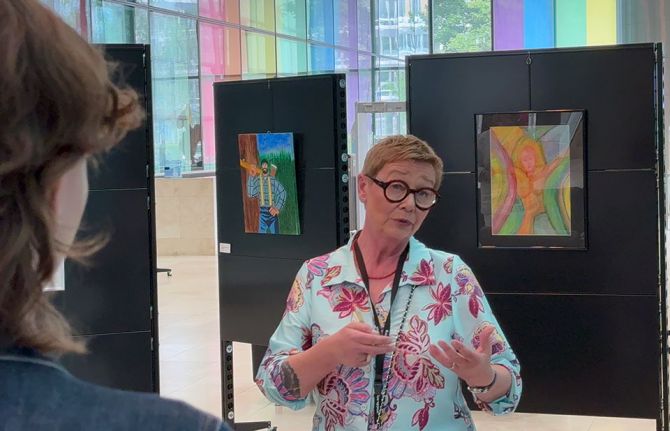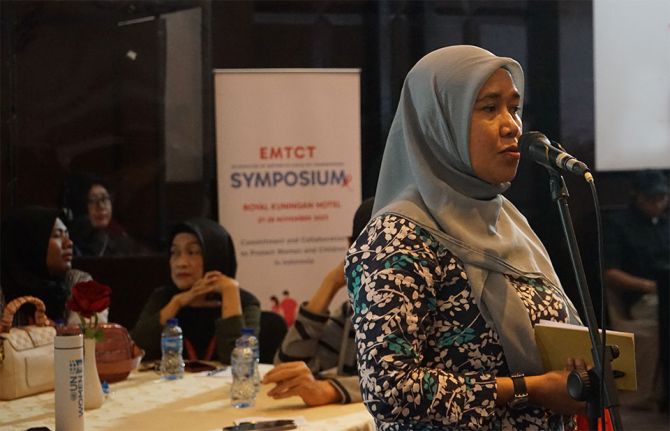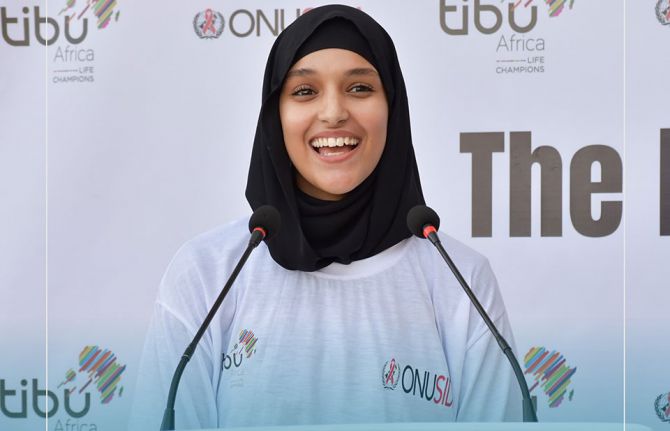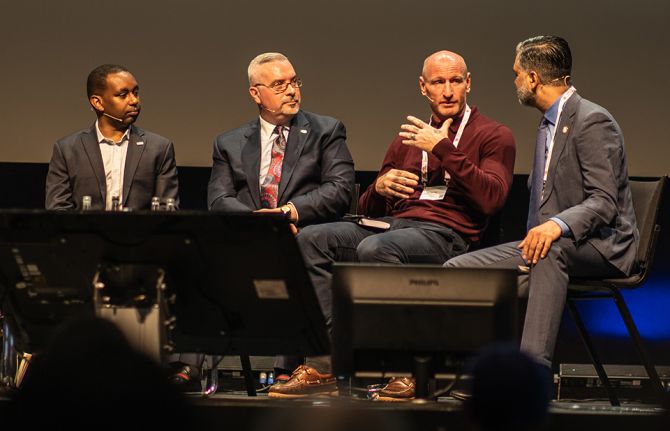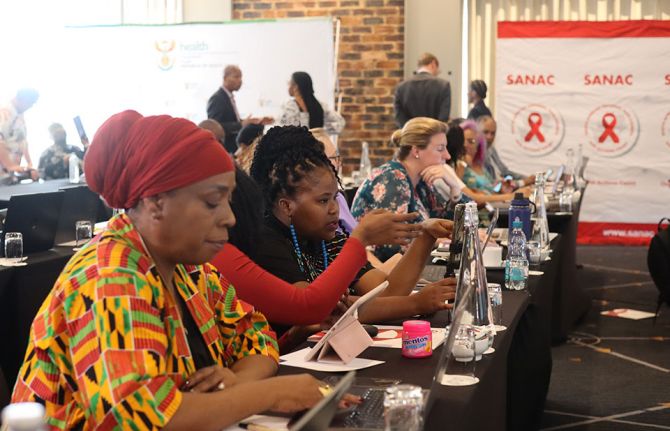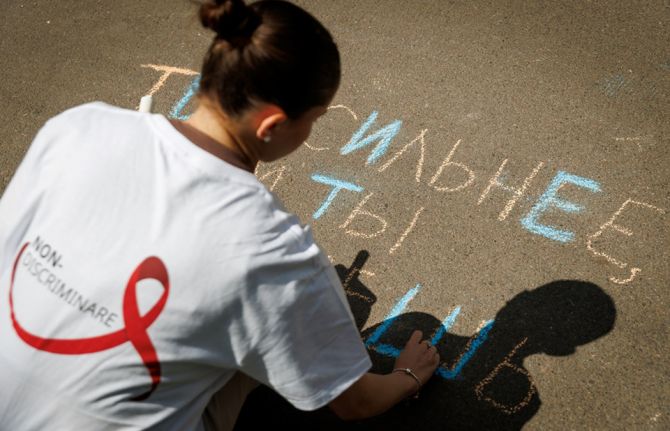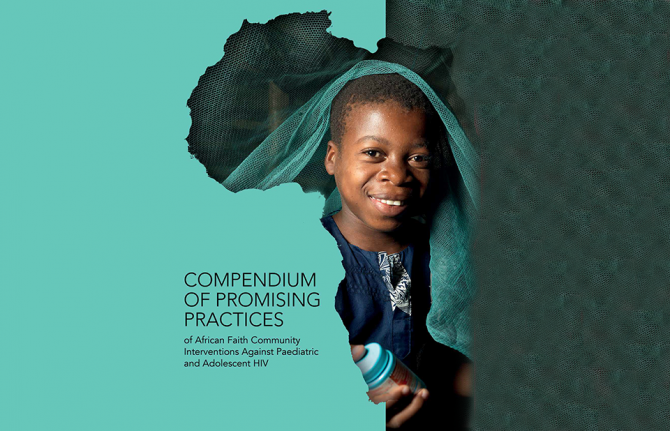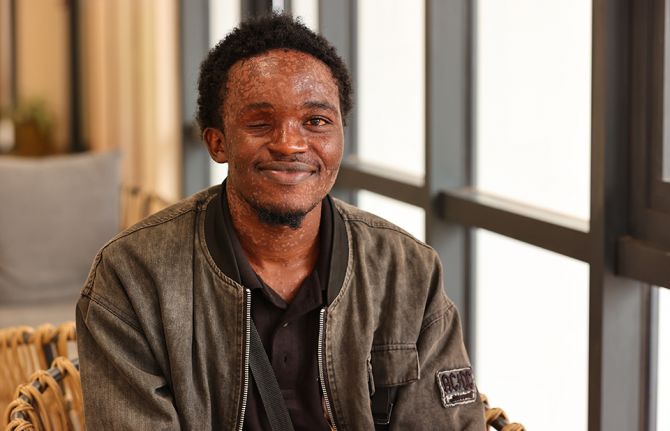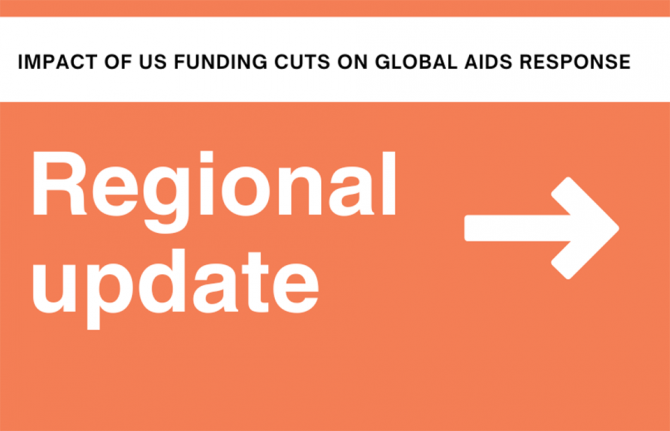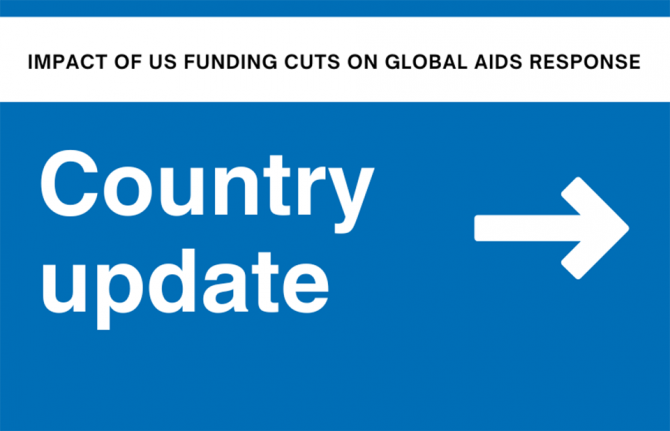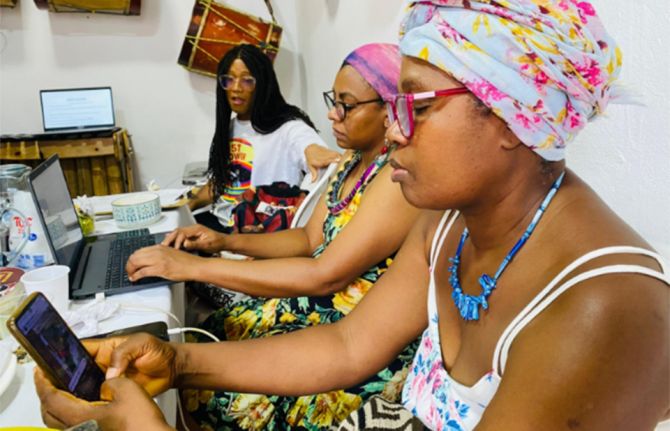
Feature Story
The Missing Face of Children and AIDS: Progress on Ten Years of Commitments
10 June 2011
10 June 2011 10 June 2011
President of Rwanda Paul Kagame speaking at The Missing Face of Children and AIDS: Progress on 10 years of Commitments held at Millennium Hotel, NYC, June 9, 2011. Credit: UNAIDS/B. Hamilton
Considerable progress has been made in putting children at the heart of the global AIDS response. Eliminating new HIV infections among children by 2015 has become an international priority and there has been a decrease in HIV incidence among the young. However, the High Level Meeting on AIDS heard this week that much more still needs to be done to ensure an AIDS-free generation.
During a side-event on 9 June called The missing face of children and AIDS: Progress on ten years of commitment, delegates explored how all children, everywhere can be assured access to good quality HIV prevention, treatment, care and support services. The meeting, which brought together heads of state, ministers, international organizations and representatives of affected populations, including youth groups, was co-hosted by UNICEF, UNAIDS and the governments of Australia and Botswana. Guests included President Paul Kagame of Rwanda and Dr Asha-Rose Migiro, UN Deputy Secretary-General.
The major goals of the event were to encourage national and global decision makers to follow through on their commitments to eliminate new HIV infections among children, to reflect on progress made towards global targets and to keep children central to the agenda throughout the High Level Meeting.
It also provided an opportunity to announce the continuation of the Unite for Children, Unite against AIDS campaign as a global multi-partner platform championing children’s issues in the challenge to HIV.
All children need to be a global priority, and not left to the lottery of geography
Michel Sidibé, UNAIDS Executive Director
In his opening remarks, Dr Anthony Lake, UNICEF Executive Director said: "We have the knowledge, we have the science and we have the power to achieve an AIDS-free generation. We can do this—and because we can, we must do it. And I believe that together, we will do it."
Participants discussed the importance of clearly defining objectives as part of a rights-based, results-focused drive to reach all those in need. These include millions of women and children still falling through the gaps. Health indicators show that there are massive inequities based on income, geography and education. Gender disparities continue to place a greater HIV burden on young women and girls and children with disabilities often have very limited access to services and protection.
It was agreed that efforts to reach the poorest, most marginalized and least served with HIV interventions must be redoubled.
Addressing the event, Michel Sidibé, UNAIDS Executive Director made an impassioned plea: "All children need to be a global priority, and not left to the lottery of geography. Unfortunately, that's what is happening."
"If we fail for children, I don't believe that we can be successful for any development agenda…If we cannot deliver for our children, if we cannot establish a society which will allow the proper redistribution of opportunity, a society in which we really deal with inequities, a society in which we really make sure that social justice will be helping us to reach those children, don't tell me that you will achieve the Millennium Development Goals, you will transform this world, you will make it better.”
Nabbumba "Princess" Nuru from Uganda who was born with HIV also addressed the assembly: "I stand here before all of you today, as a young leader in the AIDS response, to challenge you as established leaders to fully commit to the virtual elimination of mother to child transmission.”
We have the knowledge, we have the science and we have the power to achieve an AIDS-free generation. We can do this—and because we can, we must do it. And I believe that together, we will do it.
Dr Anthony Lake, UNICEF Executive Director
“I understand many of us here in this room are parents. None of you would want your child to grow up with HIV, or you would feel really bad if your child fell sick. That is how it feels for many women in Africa, very many women all over the world, who can't have access to HIV treatment in order to prevent their babies from catching the virus," she said.
The meeting concluded on an optimistic but sober note: achieving the goal of an AIDS-free generation is now within reach but only if the world sticks to the necessary commitments and takes the necessary action to make this a reality.
UN General Assembly High Level Meeting on AIDS
Thirty years into the AIDS epidemic, and 10 years since the landmark UN General Assembly Special Session on HIV/AIDS, the world has come together to review progress and chart the future course of the global AIDS response at the 2011 UN General Assembly High Level Meeting on AIDS from 8–10 June 2011 in New York. Member States are expected to adopt a new Declaration that will reaffirm current commitments and commit to actions to guide and sustain the global AIDS response.
External Links
Publications
Publications

Press Release
Around 10 million people living with HIV now have access to antiretroviral treatment
30 June 2013 30 June 2013Biggest year on year increase as numbers of people accessing antiretroviral therapy increase by 1.6 million from 2011 to 2012
GENEVA, 30 June 2013—A new report from the Joint United Nations Programme on HIV/AIDS (UNAIDS), the World Health Organization (WHO) and UNICEF, Global update on HIV treatment 2013: results, impact and opportunities, shows a huge acceleration in the roll out and uptake of antiretroviral therapy since 2011. A record 9.7 million people living with HIV were accessing treatment in 2012 compared to just over 8.1 million in 2011––an increase of 1.6 million in one year alone.
New guidelines from WHO, issued together with the report, give clear recommendations that people living with HIV should start antiretroviral therapy much earlier, and immediately in some instances. Under this new guidance some 26 million (25.9 million) people will now be eligible for antiretroviral therapy, an additional 9.2 million from the previous 2010 guidance.
“It is our moral and scientific obligation to reach as many people as we can with antiretroviral therapy” said Michel Sidibé, Executive Director of UNAIDS. “This is what we will continue to strive for and we believe that we can significantly scale up access to treatment even within the current financial envelope.”
By making strategic efficiencies in HIV programming, UNAIDS estimates that expansion of treatment can be accelerated within the existing resource needs of between US$ 22-24 billion for 2015. “With smart planning, we estimate that cost savings of around 20% could be made by 2015 which, if invested smartly, would allow us to reach yet more people with lifesaving antiretroviral therapy.”
UNAIDS estimates that cost savings could be achieved through three main areas; a reduction in costs of medicines and medical supplies, particularly as volumes increase; simplifying delivery systems; and increasing efficiencies within the overall AIDS response.
Significant successes in reducing costs have been achieved in recent years. For example the price of medicines to prevent mother to child transmission of HIV was reduced from US$ 800 in 2011 to below US$ 100 in 2013. Through a more competitive bidding process, South Africa has reduced the cost of procurement of antiretrovirals to the lowest price anywhere in the world at US$ 113 per person per year for the fixed dose combination recommended in the new guidelines. This has resulted in a 53% reduction in expenditure on antiretroviral treatment for South Africa.
The report also highlights that the United States President’s Emergency Fund for AIDS Relief (PEPFAR) estimates that by leveraging existing opportunities for cost efficiencies it has more than halved the average cost per person receiving treatment in PEPFAR supported programmes––from more than US$ 1000 per person per year in 2004 to less than US$ 400 per person per year in 2011.
Additional savings are expected as methods of testing for HIV become simpler and easier to administer (a fingerpick HIV test for example can now give results in 30 minutes). Other efficiencies are being made as more and more HIV services are being integrated into existing structures such as antenatal clinics and TB facilities.
The challenge set by the new guidelines will encourage countries, donors and partners in the AIDS response to strive for even greater results. If the recommendations in the new guidelines are implemented they would avert an estimated 13.5 million deaths and 19 million new HIV infections by 2025.

Feature Story
Champions Trophy final shines light on THINK WISE HIV awareness campaign
24 June 2013
24 June 2013 24 June 2013
UNAIDS Deputy Executive Director, Management and Governance, Jan Beagle (3rd left) participating in the THINK WISE events organized for the 2013 Champions Trophy final at the Edgbaston stadium. Credit: Getty images
The final match of the 2013 ICC Champions Trophy tournament held on Sunday 23 June in Birmingham, UK was dedicated to the THINK WISE HIV awareness campaign—a partnership between the International Cricket Council (ICC), UNAIDS and UNICEF that uses the power of cricket and cricket players to reach out to large numbers of people—particularly young people—on AIDS issues.
The final also marked the ten year partnership between ICC and UNAIDS, whose joint work commenced in 2003. UNICEF joined the partnership in 2006 and in 2009 the three partners initiated the THINK WISE awareness campaign.
As England and India battled out the 2013 Champions Trophy final at the Edgbaston stadium, THINK WISE was promoted throughout the stadium via public service broadcasts, boundary banners, promotional leaflets and through the special Final commemorative match programme, also dedicated to the 10-year AIDS partnership.
Noting the success of the 2013 Champions Trophy THINK WISE activities, ICC President Alan Isaac said, “It brings me great pleasure that the ICC’s partnership with UNAIDS and UNICEF is flourishing. Through the THINK WISE initiative, we are sending a message to the world about the importance of getting the facts about HIV and stopping stigma towards people living with HIV.”
It brings me great pleasure that the ICC’s partnership with UNAIDS and UNICEF is flourishing. Through the THINK WISE initiative, we are sending a message to the world about the importance of getting the facts about HIV and stopping stigma towards people living with HIV.
ICC President Alan Isaac
The THINK WISE campaign, which emphasizes the key messages ‘Get the facts about HIV; Protect yourself; Stop stigma’ has been profiled throughout the 2013 Champions Trophy with dedicated matches, site visits and coaching clinics with the players and other promotional activities. During the final game both teams as well as match officials and ICC and staff from the English Cricket Board wore red ribbons to raise awareness about the stigma surrounding people living with HIV.
UNAIDS Deputy Executive Director, Management and Governance, Jan Beagle, attended the final. She walked out on the pitch with the teams for the National Anthems, together with the ICC President, the Chairman of the England and Wales Cricket Board and two representatives of people living with HIV, to show solidarity with people around the globe living with HIV.
Commending the ICC on its commitment to AIDS awareness Ms Beagle said, “I am moved to see the dedication of the ICC and cricket players to promoting HIV prevention and reaching zero discrimination for people living with HIV. UNAIDS firmly believes in the ability of the THINK WISE partnership to be a powerful force for change, for more equitable and inclusive societies—within the ICC family, in communities and across countries.”
As at previous ICC international cricket tournaments, throughout the Champions Trophy international players from a selection of teams took time out to take part in THINK WISE coaching clinics and site visits. For example, the West Indies and New Zealand teams welcomed school children from London and Cardiff to special coaching sessions where they learned valuable cricketing tips and exchanged information on HIV prevention and stigma. Members of the England and South African international teams visited the Terrence Higgins Trust where they met with people living with HIV and some team members opted to take rapid HIV tests.
Multimedia
Multimedia
Related

Feature Story
International cricketers team up to ‘THINK WISE’ about HIV prevention
07 June 2013
07 June 2013 07 June 2013
60 children from three London schools had the chance to learn cricketing skills from the West Indies team as part of the THINK Wise initiative. 5 June, 2013 in London, England.
Credit: ICC/Getty Images
Cricketing greats from around the world have once more teamed up to promote HIV prevention and anti-stigma messages as part of the global THINK WISE campaign on AIDS. The initiative will run through the 2013 International Cricket Council’s Champions Trophy Tournament taking place from 6-23 June in England and Wales.
A partnership between the International Cricket Council (ICC), UNAIDS and UNICEF, THINK WISE uses the power of cricket and cricket players to reach out to large numbers of people—particularly young people—on AIDS issues. The partnership will be profiled at the prestigious international tournament through dedicated matches, site visits and coaching clinics with international players and other promotional activities.
“I am delighted once again that the ICC is partnering with THINK WISE to continue promoting the importance of HIV awareness,” said ICC Chief Executive, David Richardson.
Celebrating ten years of the ICC working with its UN partners on AIDS, the ICC is dedicating six of the Champions Trophy matches—including the Final—to THINK WISE. Messages on the importance of HIV prevention and the elimination of stigma towards people living with HIV are the central focus of the campaign.
I am delighted once again that the ICC is partnering with THINK WISE to continue promoting the importance of HIV awareness
David Richardson, Chief Executive, International Cricket Council
Over the years, THINK WISE has inspired many leading cricketers to join efforts to promote HIV prevention and reduce HIV-related stigma and discrimination. Current and former players who have championed the campaign include Kumar Sangakkara (Sri Lanka), Graeme Smith (South Africa), Stafanie Taylor (West Indies), Darren Sammy (West Indies), Shakib Al Hasan (Bangladesh) and Virender Sehwag (India).
“As we mark 10 years of action on AIDS through cricket, we have seen how cricket can unite billions of people across the globe. The THINK WISE global cricket AIDS partnership and the inspiring involvement of cricketing greats gives important profile and builds momentum towards changing and saving lives,” said UNAIDS Executive Director, Michel sidibé.
At THINK WISE matches, all participating teams and officials wear red ribbons as a sign of solidarity with people living with HIV. A public service announcement featuring Kumar Sangakkara and Virender Sehwag will be screened at selected tournament matches, THINK WISE messages will feature on the boundary boards and information about the campaign and HIV prevention will feature in match programmes.
During the tournament, players from England, New Zealand, South Africa and the West Indies will undertake specific AIDS awareness-raising activities with people living with HIV and young people.

Through interactions with the cricket players, the 60 children also had the chance to learn about HIV-related issues. 5 June, 2013 in London, England. Credit: ICC/Getty Images
West Indies urge children to THINK WISE
On the eve of the 2013 Champions Trophy opening, West Indies captain Dwayne Bravo and team-mates Darren Sammy and Jason Holder held a special coaching clinic at the Oval in London as part of the THINK WISE partnership activities. The trio attended the clinic alongside fielding coach Andre Coley and took part in a session delivered by UK NGO Cricket Without Boundaries.
Through interactions with the cricket players and coach, 60 children from three London schools had the chance to learn cricketing skills, while also understanding the background of THINK WISE and learning about HIV-related issues.
“It’s very important to get kids aware of HIV at an early age, just like sport, the earlier you get involved in something the quicker you learn about it. It’s good that THINK WISE is taking the initiative to educate children about HIV and I really enjoyed the experience,” said Dwayne Bravo
Jason Holder who is at his first senior ICC men’s tournament, added: “I think that THINK WISE is a very good imitative and it’s great that these three organisations, the ICC, UNAIDS and UNICEF, have come together for this tournament. Hopefully the partnership will continue to grow from strength to strength for years to come.”
The ICC Champions Trophy, featuring Australia, England, India, New Zealand, Pakistan, South Africa, Sri Lanka and West Indies, will be played over 18 days from 6 -23 June.
External links
External links

Feature Story
UNICEF report urges to see the child before the disability
30 May 2013
30 May 2013 30 May 2013
Children with disabilities are too often denied access to health and education and this has a detrimental effect on society as a whole. Credit: UNICEF/Marco Dormino
The marginalization of children with disabilities in critical areas like health and education not only has damaging consequences for the young people themselves but also the wider community, according to a landmark UNICEF report released today on 30 May.
The State of the World’s Children 2013: Children with Disabilities contends that children with disabilities are the least likely to receive health care or go to school. They are also more likely to face exploitation and neglect. This is because, the report suggests, children with disabilities are too often reduced to that disability and not seen as valuable individuals who should be given the same opportunities to flourish as everyone else.
"When you see the disability before the child, it is not only wrong for the child, but it deprives society of all that child has to offer," said UNICEF Executive Director Anthony Lake. “Their loss is society's loss; their gain is society's gain.”
HIV provides a salient example of how young people with physical, sensory, intellectual or psychosocial disabilities can be marginalized, overlooked and excluded from programmes. The report argues that, if the burden of the virus is increased in any one group this has negative implications for society as a whole, not least in terms of slowed development and increased expenditure.
Children with disabilities are often considered to be sexually inactive and thus not in need of HIV prevention services. Many receive no information about puberty and how their bodies change and develop. There may also be issues with a greater inability to set sexual contact boundaries for others.
In addition, a significant percentage of people with disabilities of all ages experience sexual assault or abuse during their lifetimes, especially women and girls and those in specialized institutions, schools and hospitals. Their vulnerability to HIV in these circumstances is therefore substantially increased.
When you see the disability before the child, it is not only wrong for the child, but it deprives society of all that child has to offer. Their loss is society's loss; their gain is society's gain.
UNICEF Executive Director Anthony Lake
HIV treatment, testing and counselling services can be physically difficult to access for those with disabilities or may not provide information in user-friendly formats such as Braille. Health care professionals are rarely trained to deal with such children and adolescents and may even demonstrate stigmatizing attitudes.
The State of the World’s Children sets out a number of recommendations to try to ensure that children with disabilities are included across a broad range of social, economic and cultural spheres so that they are involved in overall development.
One major recommendation involves filling the considerable information gap relating to children with disabilities. Few countries know how many such citizens there are, what disabilities they have and what level of service provision they need, making it very difficult for those needs to be met.
The report also highlights the need to remove barriers to inclusion so that environments like schools, health facilities and public transport encourage the participation of children with disabilities alongside their peers, free from discrimination. Families can also be supported to meet the higher costs of living and lost income-earning opportunities often associated with caring for affected children. It is also held to be important to ensure that children and adolescents are involved in the design and implementation of programmes and services so that they can play a role as active agents of change.
Finally, the report calls on countries to ratify and implement international commitments such as the UN Convention on the Rights of Persons with Disabilities and the Convention on the Rights of the Child. Around two thirds of them have ratified the former but for many implementation remains slow.
Publications


L to R: UNFPA Executive Director, Professor Babatunde Osotimehin, UNICEF Executive Director, Anthony Lake, Minister of Health of Botswana, Rev. Dr John Seakgosing, Director General of the World Health Organization, Dr Margaret Chan and UNAIDS Executive Director, Michel Sidibé. Credit: UNAIDS
Feature Story
United Nations agencies meet with President and government officials of Botswana ahead of High-Level Dialogue on Health
05 March 2013
05 March 2013 05 March 2013Ahead of the High-Level Dialogue on Health in the Post-2015 Development Agenda, held in Gaborone Botswana from 5-6 March 2013, four heads of United Nations agencies met with the President of Botswana, Ian Khama to discuss the meeting’s implications to global health.
President Khama said that his country strongly believed in investing in health and other social sectors as a way forward to economic and social development. The President stressed that despite competing priorities, governments should place human resources at the top of their national development agenda. Without a healthy population, all other priorities become void, he added.
In attendance the Director General of the World Health Organization, Dr Margaret Chan, UNICEF Executive Director, Anthony Lake, UNFPA Executive Director, Professor Babatunde Osotimehin and UNAIDS Executive Director, Michel Sidibé.
According to the 2012 UNAIDS Global Report, service coverage in Botswana to prevent new HIV infections among children reached 94% in 2011. Furthermore, by the end of 2011, more than 175 000 people were receiving antiretroviral treatment compared to 57% in 2004—more than 95% of people eligible.
Later in the day, they met with the Vice President of Botswana, Ponatshego Kedikilwe, Minister for Presidential Affairs and Public Administration, Mokgweetsi Masisi, Minister of Health, Rev. Dr John Seakgosing and Minister of Finance and Development Planning, Ontefetse Matambo.
Quotes
We are convening one of the milestone events in health development here not by coincidence. It is because Botswana's AIDS response has become a model for others.
Related

Press Statement
UNAIDS and UNICEF welcome news of a baby born with HIV who now as a toddler appears “functionally cured” through treatment
04 March 2013 04 March 2013And looks forward to further studies to see if findings can be replicated.
GENEVA, 4 March 2013—The Joint United Nations Programme on HIV/AIDS (UNAIDS) and UNICEF welcome a new case study, which found a baby treated with antiretroviral drugs in the first 30 hours of life and who continued on HIV treatment for 18 months appeared to be functionally cured.
The findings were presented today at the Conference on Retroviruses and Opportunistic Infections (CROI) in Atlanta, Georgia in the United States of America.
According to researchers the mother who was living with HIV at the time of birth had not received antiretroviral (ARV) medication or prenatal care. Researchers say that the child was born prematurely in July 2010 in the state of Mississippi. Due to the high risk of exposure to HIV, the researchers say the baby was started on a triple therapy regimen of antiretroviral drug 30 hours after birth and before proof of infection could be confirmed. The newborn’s HIV-positive status was subsequently confirmed through a highly sensitive polymerase chain reaction testing which was conducted on several occasions.
The case study stated that the baby was discharged from the hospital after one week and continued ARV treatment until 18 months of age, when for reasons that are unclear the treatment was discontinued. However, when the child was seen by medical professionals about a half a year later, blood samples revealed undetectable HIV levels and no HIV-specific antibodies.
If the findings are confirmed this would be the first well-documented case of an HIV-positive child who appears to have no detectable levels of the virus despite stopping HIV treatment.
“This news gives us great hope that a cure for HIV in children is possible and could bring us one step closer to an AIDS free generation,” said UNAIDS Executive Director Michel Sidibé. “This also underscores the need for research and innovation especially in the area of early diagnostics.”
In 2011, UNAIDS and its partners launched a Global plan for the elimination of new HIV infections among children by 2015 and keeping their mothers alive. Significant progress has been made and continued support and research is needed.
“While we wait for these results to be confirmed with further research, it is potentially great news,” said UNICEF Executive Director, Anthony Lake. “This case also demonstrates what we already know—it is vital to test newborn babies at risk as soon as possible.”
According to data from the World Health Organization and UNICEF only 28% of HIV-exposed babies were tested for HIV within six weeks of birth in 2010. Obstacles to early diagnosis and treatment include the high cost of diagnostics and difficulty of getting timely results and limited access to services and medicines. There were 330 000 children newly infected with HIV in 2011. At the end of 2011, 28% of children under the age of 15 living with HIV were on HIV treatment, compared to 54% of eligible adults.
Now two and a half year’s old, the toddler continues to thrive without antiretroviral therapy and has no identifiable levels of HIV. However, UNAIDS cautions that more studies need to be conducted to understand the outcomes and whether the current findings can be replicated.
Contact
UNAIDS GenevaSaya Oka
tel. +41 22 791 1552
okas@unaids.org
UNICEF
Sarah Crowe
tel. + 1 646 209 1590
scrowe@unicef.org
Multimedia
Multimedia
Press centre
Download the printable version (PDF)

Feature Story
Eliminating new HIV infections among children and keeping their mothers alive is not just about pills
14 December 2012
14 December 2012 14 December 2012
Credit: UNAIDS/D.Kwande
A mid-term review on the implementation of the Global Plan Towards the Elimination of New HIV infections among Children by 2015 and Keeping their Mothers Alive took place in Nairobi, Kenya from 6-7 December. The two-day workshop discussed the way forward in overcoming three key bottlenecks to achieve the Global Plan targets, including early infant diagnosis, human resources for health and supply chain management.
In June 2011, UNAIDS and the President’s Emergency Plan for AIDS Relief (PEPFAR) unveiled the Global Plan with two main targets for 2015: a 90% reduction in the number of children newly infected with HIV and a 50% reduction in the number of AIDS-related maternal deaths. The Global Plan focuses on 22 priority countries with the highest estimated numbers of pregnant women living with HIV.
Opening the meeting, US Deputy Global AIDS Coordinator Deborah Von Zinkernagel noted the momentum that has been gained in the 18 months since the launch of the Global Plan. “Strong political leadership, progressive policy change, and accelerated programmatic scale up at various levels are helping to significantly reduce new HIV infections among children and AIDS-related deaths among mothers,” said Ms Von Zinkernagel. “While the job is far from done, the intensified efforts of many partners under the Global Plan are advancing our progress towards the goal of achieving an AIDS-Free Generation”, she added.
Speaking about the challenges, participants highlighted that immediate confirmation of HIV infection in children is urgent to ensure timely initiation of antiretroviral therapy, as half of the children infected with the virus die before the age of two years. UNAIDS estimates that in 2010, among 65 reporting countries, only 28% of infants born to mothers living with HIV received an HIV test within the first two months of life. In 2011, 230 000 children died from HIV-related causes worldwide and only 28% of children eligible for treatment were receiving it, compared to 54% of adults.
Participants also stressed that, despite progress made in the provision of services to prevent mother-to-child transmission of HIV, access to appropriate diagnostics and/or treatment for pregnant women still remained inadequately low. According to UNAIDS, the percentage of treatment-eligible pregnant women living with HIV who were receiving antiretroviral therapy for their own health in 2011 was an estimated 30%.
In countries like the Democratic Republic of Congo, Chad, and Nigeria, less than 20% of pregnant women received HIV testing and counselling in 2010. Participants noted that, in some cases, the lack of access to these services is caused by uninformed or misguided government policies that do not prioritise the provision of this life-saving treatment.
Overall supply chain challenges, and in particular, the cost of commodities have overarching implications. Participants agreed that without an effective supply chain, the goals of the Global Plan are impossible to meet. Strategies such as pooling and integrating procurement, strengthening and harmonizing regulatory systems, systems transparency, and improving the accuracy of commodity forecasting to reduce stock wastage are critical to maximize supply chain efficiency. The meeting also discussed the importance of predictable funding and skilled personnel to enable efficient logistics management while lowering costs.
A shortage of human resources for health, including doctors, nurses and midwives was discussed as a major bottleneck in rapidly expanding HIV prevention, treatment and support services for mothers and children. Many of the participating countries are experimenting with task-shifting and task-sharing, as well as working with community and lay health workers in order to stretch the reach of health care services. Strategies that can accelerate the recruitment, retention and retraining of health care providers were shared, such as formalizing the role of community health workers, the development of a formal professional management cadre to oversee health facilities, and accelerated pre-service training schemes.
While the job is far from done, the intensified efforts of many partners under the Global Plan are advancing our progress towards the goal of achieving an AIDS-Free Generation
US Deputy Global AIDS Coordinator Deborah Von Zinkernagel
Participants agreed that eliminating new HIV infections among children and keeping their mothers alive is not, and should not be, just about pills. It is first and foremost about protecting the health, dignity and security of mothers living with HIV and their children. They heard reports of human rights violations of women living with HIV such as mandatory HIV testing, forced sterilizations, as well as stigma and discrimination especially in the health care setting. Networks of women living with HIV demonstrated how they have been overcoming these challenges including sensitizing communities on their rights, demanding action and accountability from governments and other stakeholders, and playing a central role within their country programs to end vertical transmission. During the workshop, participants agreed on key actions required for progress to be made against the targets of the Global Plan in these areas. Participants also discussed the global financing architecture, and how to maximize towards available resources such as Global Fund and PEPFAR, but beginning with their own domestic funding.
Closing the meeting, the Director of the Department of Evidence, Innovation and Policy at UNAIDS Dr Bernhard Schwartlander, commended countries for their rapid momentum. “The call for elimination of new HIV infections among children by 2015 and keeping their mothers alive has been widely heard”, he said, “and countries are now making important and sustained investments for their populations. It is now time to notch up our efforts as we enter the second phase of the Global Plan, and be better accountable to our governments and the people we serve.”
The meeting was attended by government representatives from 16 of the 22 priority countries under the Global Plan, as well as representatives from PEPFAR, the UN, and several global implementing agencies. Others present included Women Fighting AIDS in Kenya (WOFAK), The International Community of Women with HIV/AIDS (ICW), and the Inter-Agency Task Team on the Prevention and Treatment of HIV among Pregnant Women, Mothers and Children.
Related

Feature Story
Gaming for HIV prevention: a public-private partnership in Gabon
29 November 2012
29 November 2012 29 November 2012
Young people from Gabon playing the interactive board game “Vie2Jeune”.
Credit: Aiducators4life
According to the Ministry of Health of Gabon, only 1 out of 2 young Gabonese aged 15-24 have a comprehensive knowledge on HIV in a country where the prevalence rate among youth aged 15-24 is about 4.8%, and 15% of youth have sexual relationships before the age of 15.
In an effort to revolutionise HIV prevention in Gabon, Shell Gabon in co-operation with the non-governmental organization Aiducators4life, the government and UNICEF launched an innovative tool aimed at stimulating discussions on HIV among youth (13+) in the country.
“Shell is truly committed to slow the spread of HIV in this country,” said the Director General of Shell Gabon, Adrian Drewett who officially launched the board game on the 3rd of December at Lycee Paul Indjendjet Gondjout in Libreville.
The new tool consists of an interactive board game called “Vie2Jeune”. Aligned with Gabonese culture and customs, the game provides relevant information for young people on topics like safe sex, sexually transmitted infections, facts about HIV, teenage pregnancies and discrimination against people living with HIV. There are about 60 information cards and 60 question cards that are used while playing the game.
This is a very direct and very ‘fun’ approach to learning about HIV
UNAIDS coordinator in Gabon, Ms Inge Tack
This board game was successfully launched in Zambia in 2009. The new French version was developed by Aiducators4life in cooperation with a French biology teacher and a French language teacher. The game is approved by medical experts and it has been tested extensively in schools in both Libreville and Gamba.
The entertaining format of the game makes it easily acceptable in many cultures and people groups especially where readership is low. “This is a very direct and very ‘fun’ approach to learning about HIV,” said UNAIDS coordinator in Gabon, Ms Inge Tack. “We noticed during the tests that this approach was very effective and also different to the current methods used in schools.”
Shell Gabon will finance 1000 games for secondary schools in Gamba and Libreville. The final objective is to provide all Gabonese secondary schools with the game which has just been approved for educational purpose by the Gabonese Ministry of Education. The distribution of the game will start in January 2013.
External Links
External Links

Feature Story
Young people living with HIV in Latin America make their voices heard
18 October 2012
18 October 2012 18 October 2012
The Network of Positive Youth for Latin America and the Caribbean has launched a regional consultation for young people living with HIV. The aim of the consultation is to obtain information on the realities that young people living with HIV face in their everyday lives in order to develop new and more effective HIV strategies focused on their specific needs.
The consultation tool, developed with support from UNAIDS, UNICEF and UNFPA, consists of an online and confidential survey of roughly 40 questions that focuses on young people aged 18 to 29 years old and living with HIV from 17 Latin American and two Spanish-speaking Caribbean countries. The online platform is designed to run on any computer and has a special program to facilitate access from mobile devices.
The tool will collect information related to the socio-demographic aspects of young people living with HIV, their access to health services, experiences with stigma and discrimination, and their leadership and community participation. Young people living with HIV will be able to participated in the survey until 30 November 2012 at the following website: http://consulta.jovenespositivos.org
“Usually, positive youth remain invisible to research and data collection exercises. This consultation is an opportunity to make our voices heard,” explained Mariana Iacono, a founding member of the Network of Positive Youth. “To be able to develop HIV strategies and programs that meet our needs we must know our situation, needs and realities in our communities.”
A team of young people from the Network of Positive Youth will analyze the results of the online consultation and will design a short and long term action plans for the region. The results will also serve as advocacy tools to demand the development of national strategies that focus on the needs of young people living with HIV. “We know that sometimes it is difficult to share feelings and memories, but we believe it is from our own experiences that we can bring new ideas and solutions to address HIV in a more inclusive and cost effective way,” said Pablo Aguilera, member of the Network.
To be able to develop HIV strategies and programs that meet our needs we must know our situation, needs and realities in our communities
Mariana Iacono, a founding member of the Network of Positive Youth
In Latin America, an estimated 68 000 adolescents (10-19 years) are living with HIV. Of these, 34 680 are women. In 2011, 34 440 new HIV infections occurred among young people between 15 to 24 years, accounting for 41% of all adult HIV infections. “A generation of young people born with HIV is growing up with its specific needs being largely neglected,” noted Mark Connolly, UNICEF Senior Adviser for Latin America and the Caribbean. In 2011, an estimated 2 000 children were born with HIV in the region.
As young people living with HIV transition from childhood through adolescence to young adulthood, they face a range of specific needs, including accessing treatment, tackling stigma and discrimination, and accessing youth-friendly integrated HIV and sexual and reproductive health services. “Young people living with HIV are a heterogeneous group, with diverse populations that needs urgent attention in many areas, especially those who are more affected by stigma and discrimination, such as transgender, gays and drug users,” said Cesar A. Núñez, UNAIDS Regional Director for Latin America.
The UNFPA Regional Director for Latin America and the Caribbean, Marcela Suazo emphasized that the epidemic on positive young people is worsened because of social exclusion, as well as gender inequality, stigma and discrimination related to HIV. “It is necessary to ensure a human rights platform that extends strongest non-discriminatory access of young people to education, counseling and adequate sexual and reproductive health," she said.
In Latin America, a new wave of youth-led community mobilization is emerging, advocating for human rights and demanding access to HIV services. The Regional Network of Positive Youth is organizing youth to participate in decision-making and consultation spaces beyond national spheres. In December 2012, the Network is organizing the first regional meeting of young people to define coordinated actions across the region, enhance leadership and mobilization towards meeting the global targets for 2015.

